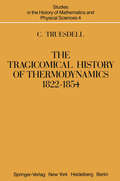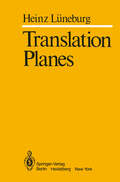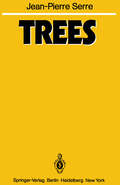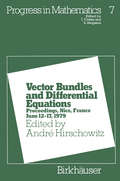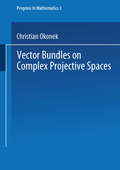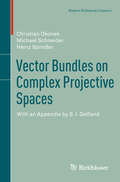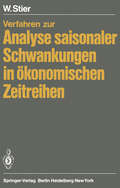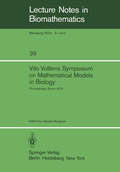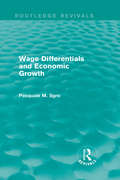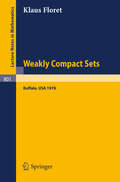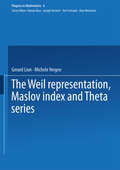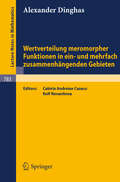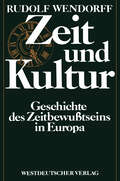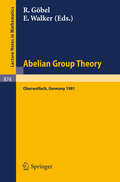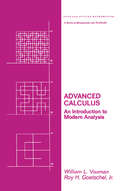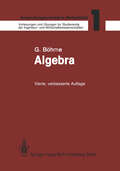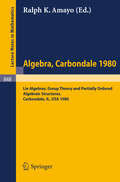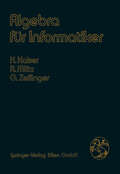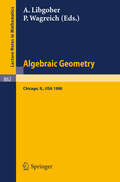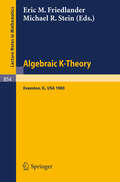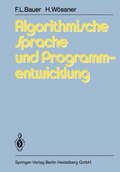- Table View
- List View
The Tragicomical History of Thermodynamics, 1822–1854 (Studies in the History of Mathematics and Physical Sciences #4)
by C. TruesdellTrees (Springer Monographs In Mathematics Ser.)
by Jean-Pierre SerreThe seminal ideas of this book played a key role in the development of group theory since the 70s. Several generations of mathematicians learned geometric ideas in group theory from this book. In it, the author proves the fundamental theorem for the special cases of free groups and tree products before dealing with the proof of the general case. This new edition is ideal for graduate students and researchers in algebra, geometry and topology.
Vector Bundles and Differential Equations: Proceedings, Nice, France June 12–17, 1979 (Progress in Mathematics #7)
by André HirschowitzVector Bundles on Complex Projective Spaces (Progress in Mathematics #3)
by Christian Okonek Heinz Spindler Michael SchneiderThese lecture notes are intended as an introduction to the methods of classification of holomorphic vector bundles over projective algebraic manifolds X. To be as concrete as possible we have mostly restricted ourselves to the case X = Fn. According to Serre (GAGA) the classification of holomorphic vector bundles is equivalent to the classification of algebraic vector bundles. Here we have used almost exclusively the language of analytic geometry. The book is intended for students who have a basic knowledge of analytic and (or) algebraic geometry. Some funda mental results from these fields are summarized at the beginning. One of the authors gave a survey in the Seminaire Bourbaki 1978 on the current state of the classification of holomorphic vector bundles overFn. This lecture then served as the basis for a course of lectures in Gottingen in the Winter Semester 78/79. The present work is an extended and up-dated exposition of that course. Because of the introductory nature of this book we have had to leave out some difficult topics such as the restriction theorem of Barth. As compensation we have appended to each sec tion a paragraph in which historical remarks are made, further results indicated and unsolved problems presented. The book is divided into two chapters. Each chapter is subdivided into several sections which in turn are made up of a number of paragraphs. Each section is preceeded by a short description of iv its contents.
Vector Bundles on Complex Projective Spaces: With an Appendix by S. I. Gelfand (Modern Birkhäuser Classics)
by Christian Okonek Michael Schneider Heinz SpindlerThese lecture notes are intended as an introduction to the methods of classi?cation of holomorphic vector bundles over projective algebraic manifolds X. To be as concrete as possible we have mostly restricted ourselves to the case X = P . According to Serre (GAGA) the class- n cation of holomorphic vector bundles is equivalent to the classi?cation of algebraic vector bundles. Here we have used almost exclusively the language of analytic geometry. The book is intended for students who have a basic knowledge of analytic and (or) algebraic geometry. Some fundamental results from these ?elds are summarized at the beginning. One of the authors gave a survey in the S´eminaire Bourbaki 1978 on the current state of the classi?cation of holomorphic vector bundles over P . This lecture then served as the basis for a course of lectures n in G¨ottingen in the Winter Semester 78/79. The present work is an extended and up-dated exposition of that course. Because of the - troductory nature of this book we have had to leave out some di?cult topics such as the restriction theorem of Barth. As compensation we have appended to each section a paragraph in which historical remarks are made, further results indicated and unsolved problems presented. The book is divided into two chapters. Each chapter is subdivided into several sections which in turn are made up of a number of pa- graphs. Each section is preceded by a short description of its contents.
Vito Volterra Symposium on Mathematical Models in Biology: Proceedings of a Conference Held at the Centro Linceo Interdisciplinare, Accademia Nazionale dei Lincei, Rome December 17 – 21, 1979 (Lecture Notes in Biomathematics #39)
by Claudio BarigozziThe idea of organizing a symposium on mathematical models in biology came to some colleagues, members of the Accademia dei Lincei, in order to point out the importance of mathematics not only for supplying instruments for the elaboration and the evaluation of experimental data, but also for discussing the possibility of developing mathematical formulations of biological problems. This appeared particularly appropriate for genetics, where mathematical models have been of historical importance. When the organizing work had started, it became clear to us that the classic studies of Vito Volterra (who was also a Member of the Academy and its President from 1923 to 1926) might be con sidered a further reason to have the meeting in Rome at the Accademia dei Lincei; thus the meeting is dedicated to his memory. Biology, in its manifold aspects proved to Se ~ difficult object for an exhaustive approach; thus it became necessary for practical reasons to make a choice of problems. Therefore not all branches of biology have been represented. The proceedings of the symposium, as a whole, assume a knowledge of mathematics on the part of the reader; however the problem of teaching mathematics to biologists was the subject of a round table discussion, not recorded in these proceedings. On this were brought up some basic points to be recommended to teachers on an international basis, and a statement was prepared for circulation. The Organizing Committee TABLE OF CONTENTS TOPIC I MODELS OF NATUPAL SELECTION . . . . . . . • . . . .
Von Fermat bis Minkowski: Eine Vorlesung über Zahlentheorie und ihre Entwicklung
by W. Scharlau H. OpolkaWage Differentials and Economic Growth (Routledge Revivals)
by Pasquale SgroThis book, which was first published in 1980, is concerned with one particular branch of growth theory, namely descriptive growth theory. It is typically assumed in growth theory that both the factors and goods market are perfectly competitive. In particular this implies amongst other things that the reward to each factor is identical in each sector of the economy. In this book the assumption of identical factor rewards is relaxed and the implications of an intersectoral wage differential for economic growth are analysed. There is also some discussion on the short-term and long-run effects of minimum wage legislation on growth. This book will serve as key reading for students of economics.
Wage Differentials and Economic Growth (Routledge Revivals)
by Pasquale SgroThis book, which was first published in 1980, is concerned with one particular branch of growth theory, namely descriptive growth theory. It is typically assumed in growth theory that both the factors and goods market are perfectly competitive. In particular this implies amongst other things that the reward to each factor is identical in each sector of the economy. In this book the assumption of identical factor rewards is relaxed and the implications of an intersectoral wage differential for economic growth are analysed. There is also some discussion on the short-term and long-run effects of minimum wage legislation on growth. This book will serve as key reading for students of economics.
Weakly Compact Sets: Lectures Held at S.U.N.Y., Buffalo, in Spring 1978 (Lecture Notes in Mathematics #801)
by K. FloretThe Weil representation, Maslov index and Theta series (Progress in Mathematics #6)
by Gerard Lion Michele VergneThis is a collection of research-oriented monographs, reports, and notes arising from lectures and seminars on the Weil representation, the Maslov index, and the Theta series. It is good contribution to the international scientific community, particularly for researchers and graduate students in the field.
Wertverteilung meromorpher Funktionen in ein- und mehrfach zusammenhängenden Gebieten (Lecture Notes in Mathematics #783)
by A. DinghasAbelian Group Theory: Proceedings of the Oberwolfach Conference, January 12-17, 1981 (Lecture Notes in Mathematics #874)
by R. Göbel E. WalkerAdvanced Calculus: An Introduction to Modern Analysis (Pure and Applied Mathematics #63)
by VoxmanAdvanced Calculus: An Introduction to Modem Analysis, an advanced undergraduate textbook,provides mathematics majors, as well as students who need mathematics in their field of study,with an introduction to the theory and applications of elementary analysis. The text presents, inan accessible form, a carefully maintained balance between abstract concepts and applied results ofsignificance that serves to bridge the gap between the two- or three-cemester calculus sequence andsenior/graduate level courses in the theory and appplications of ordinary and partial differentialequations, complex variables, numerical methods, and measure and integration theory.The book focuses on topological concepts, such as compactness, connectedness, and metric spaces,and topics from analysis including Fourier series, numerical analysis, complex integration, generalizedfunctions, and Fourier and Laplace transforms. Applications from genetics, spring systems,enzyme transfer, and a thorough introduction to the classical vibrating string, heat transfer, andbrachistochrone problems illustrate this book's usefulness to the non-mathematics major. Extensiveproblem sets found throughout the book test the student's understanding of the topics andhelp develop the student's ability to handle more abstract mathematical ideas.Advanced Calculus: An Introduction to Modem Analysis is intended for junior- and senior-levelundergraduate students in mathematics, biology, engineering, physics, and other related disciplines.An excellent textbook for a one-year course in advanced calculus, the methods employed in thistext will increase students' mathematical maturity and prepare them solidly for senior/graduatelevel topics. The wealth of materials in the text allows the instructor to select topics that are ofspecial interest to the student. A two- or three�ll?lester calculus sequence is required for successfuluse of this book.
Advanced Calculus: An Introduction to Modern Analysis (Chapman & Hall/CRC Pure and Applied Mathematics #63)
by VoxmanAdvanced Calculus: An Introduction to Modem Analysis, an advanced undergraduate textbook,provides mathematics majors, as well as students who need mathematics in their field of study,with an introduction to the theory and applications of elementary analysis. The text presents, inan accessible form, a carefully maintained balance between abstract concepts and applied results ofsignificance that serves to bridge the gap between the two- or three-cemester calculus sequence andsenior/graduate level courses in the theory and appplications of ordinary and partial differentialequations, complex variables, numerical methods, and measure and integration theory.The book focuses on topological concepts, such as compactness, connectedness, and metric spaces,and topics from analysis including Fourier series, numerical analysis, complex integration, generalizedfunctions, and Fourier and Laplace transforms. Applications from genetics, spring systems,enzyme transfer, and a thorough introduction to the classical vibrating string, heat transfer, andbrachistochrone problems illustrate this book's usefulness to the non-mathematics major. Extensiveproblem sets found throughout the book test the student's understanding of the topics andhelp develop the student's ability to handle more abstract mathematical ideas.Advanced Calculus: An Introduction to Modem Analysis is intended for junior- and senior-levelundergraduate students in mathematics, biology, engineering, physics, and other related disciplines.An excellent textbook for a one-year course in advanced calculus, the methods employed in thistext will increase students' mathematical maturity and prepare them solidly for senior/graduatelevel topics. The wealth of materials in the text allows the instructor to select topics that are ofspecial interest to the student. A two- or three ll?lester calculus sequence is required for successfuluse of this book.
Algebra. Carbondale 1980.: Lie Algebras, Group Theory and Partially Ordered Algebraic Structures. Proceedings of the Southern Illinois Algebra Conference, Carbondale, April 18-19, 1980 (Lecture Notes in Mathematics #848)
by Ralph K. AmayoAlgebra für Informatiker
by Hans Kaiser Rainer Mlitz Gisela ZeilingerDas Kernstück des vorliegenden Buches entstand aus einer einsemestrigen Vor lesung gleichen Namens, die die Autoren seit mehreren Studienjahren an der Technischen Universität Wien betreuen und die von R.Mlitz ausgearbeitet wurde. Es erschien den Autoren notwendig bzw. zweckmäßig dieses Kernstück zu ergänzen durch lineare Algebra - die an der TU Wien getrennt vorgetragen wird - und graphentheoretische Grundbegriffe. Die von den Autoren gewonnenen Erfahrungen haben die vom üblichen Schema abweichenden didaktischen Aspekte der Darstellung geprägt, deren Grundprinzip in der nachfolgenden Einleitung erläutert wird. Das Buch richtet sich zunächst an Studierende der Informatik zum Gebrauch neben entsprechenden Vorlesungen, zum Nachschlagen und Wiederholen. Darüber hinaus soll der Anwender angesprochen werden, der in dem Werk die wichtigsten algebraischen Methoden des Informatikers dargeboten findet. Die Darstellung beschränkt sich auf den mathematischen Hintergrund und dessen direkte Anwendung. Bezüglich eventueller technischer Realis;erungen sei auf die entsprechende Literatur verwiesen. Unser besonderer Dank gilt Frau E.Wiesenbauer und Frau H.Reinauer für die sorgfältig durchgeführten Schreibarbeiten, Herrn Mag.W.Nowak für die genaue Ausführung der Graphiken, sowie dem Springer-Verlag Wien für sein Entgegenkommen und die gute Zusammenarbeit.
